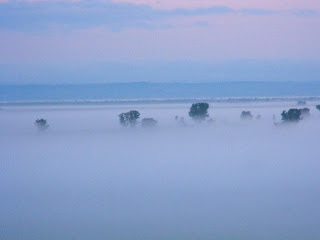The unusually wet and variable weather we were experiencing at the beginning of the month has continued. Dark clouds dance across the sky and leave you uncertain when or whether the rain will begin to fall without warning. At any moment of the day, you can scan the horizon and see rain falling somewhere in the distance. The cloud cover and breezes have kept the temperatures mild and pleasant.

At the end of a particularly wet and rainy day, the sun came out warming up the wetlands which caused the valley below the terrace to fill with mist, leaving only the tops of the trees to be visible.
Another surprise was an afternoon hailstorm that pelted us after lunch for about 30 minutes.
The intermittent rain has brought out one of the strangest creatures that is found in the park.
Although this animal superficially resembles a horseshoe crab, it is actually a type of shrimp in the genus Triops. These types of shrimp are found throughout the world and their eggs hatch after warm summer rains. These eggs have a remarkable capacity to withstand drought and extreme temperatures. They have been known to hatch 25 years after being laid. The adults live for approximately 30 days and can reach their full size of roughly three inches in a couple of days.
The show of wildflowers is still continuing at the park, with several new species beginning to bloom this week including two species of red lily.
Among the wildflowers, pitfall traps used to study small mammal diversity within the park have continued to turn out a menagerie of cute faces.
More young faces are also being seen at the park as new fledgling birds begin to leave the nest like the Common Kestrel and Stone Chat pictured below.
Lastly, I wanted to leave you this week with a gratuitous crane photo as a reminder of just how magical











































